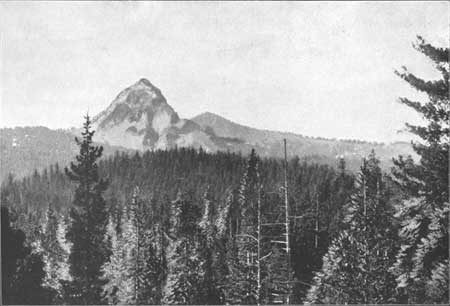
|
Geological Survey Professional Paper 3
The Geology and Petrography of Crater Lake National Park |
THE GEOLOGY OF CRATER LAKE NATIONAL PARK
By JOSEPH SILAS DILLER.
UNION PEAK.
Union Peak (elevation 7,881 feet.) is on the summit of the Cascade Range, in Oregon, about 50 miles north of the California line and 8 miles southwest of Crater Lake. It is a sharp, conical peak (Pl. III, A) rising about 1,400 feet above the general level of the crest of the range. About the base upon the east and west sides, as well as upon its summit, are remnants of the original tuff cone, but the mass of the peak exposed on all sides is of solid lava. The molten material did not sink away after the final eruption. The volcanic neck resulted from the cooling of lava within the cinder-cone in the top of the volcanic chimney. Union Peak to-day shows us the neck stripped of its cinder-cone.

Plate III.—A. UNION PEAK
MOUNT THIELSEN.
Mount Thielsen (elevation 9,250 feet), the Matterhorn of the Cascade Range, is 12 miles north of Crater Lake and rises about 2,000 feet above the general level of the crest of the range. It is built up of bright-red, yellow, and brown layers of tuff, interbedded with thin sheets of lava, and is cut by a most interesting network of dikes radiating from the center of the old volcano. No trace of a volcanic neck is present—the peak is but a remnant carved out of the lava and tuff cone surrounding the vent. After the final eruption the molten material withdrew from the cone before consolidation, so as to leave no volcanic neck corresponding to that of Union Peak. The subsidence within the chimney of Mount Thielsen after eruption must have been over 1,000 feet, for the sheets of lava effused from that vent reach more than 1,000 feet above the exposed throat of the old volcano.
| <<< Previous | <<< Contents >>> | Next >>> |
pp/3/part1-2.htm
Last Updated: 07-Mar-2006